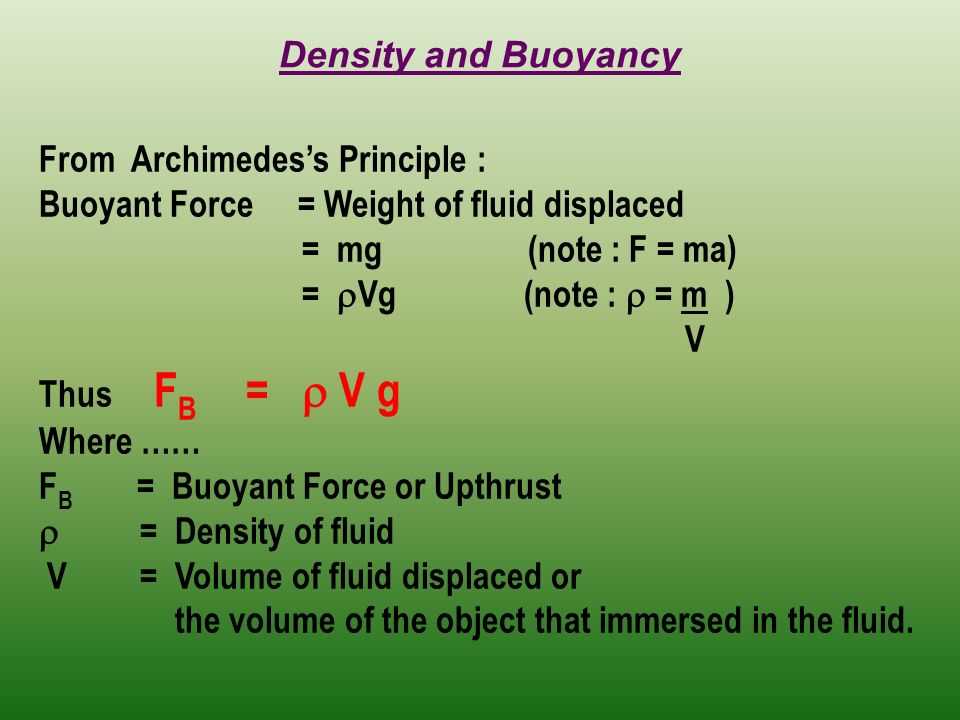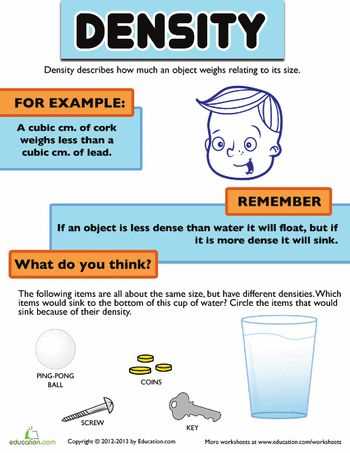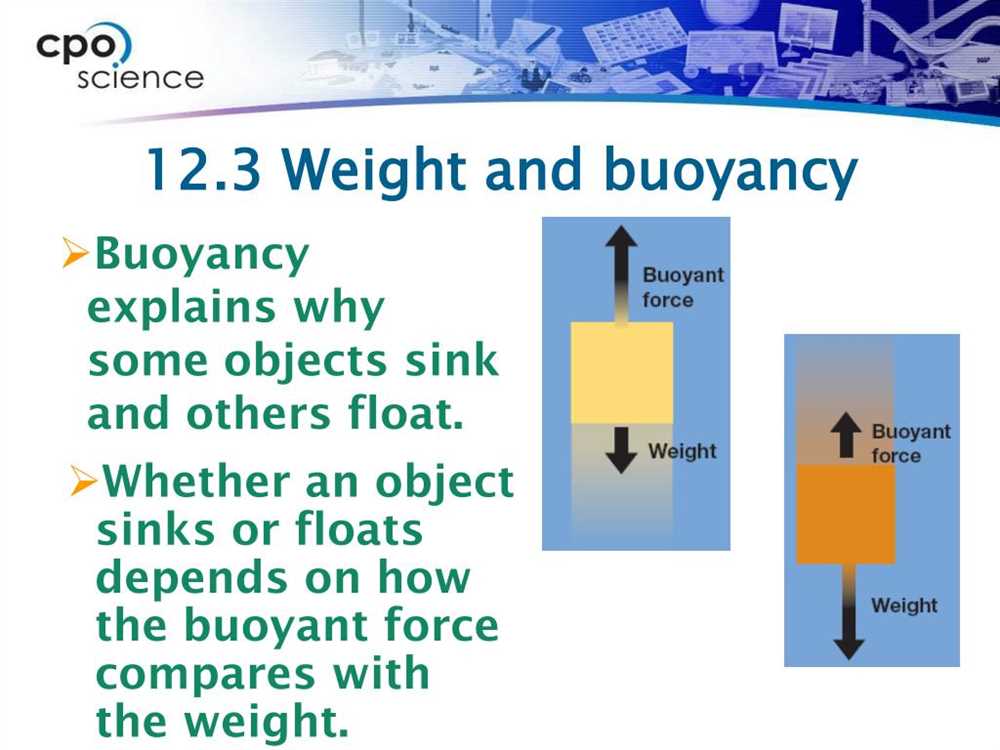
When it comes to understanding the concepts of density and buoyancy, having a reliable answer key is crucial. These concepts are fundamental to understanding the behavior of objects in various fluid mediums. A density and buoyancy worksheet answer key provides students with a comprehensive guide to solving problems and grasping the key ideas behind these concepts.
In the realm of physics, density is a measure of how much mass is packed into a given volume. It is an intrinsic property of matter and plays a significant role in determining the behavior of objects in different environments. Understanding how to calculate density is essential for solving various problems related to buoyancy, as density is directly related to an object’s ability to float or sink.
Buoyancy, on the other hand, is the upward force exerted by a fluid on an object immersed in it. This force is caused by the difference in pressure between the top and bottom of the submerged object. It is buoyancy that allows objects to float or sink in fluids, and understanding its principles is essential for predicting the behavior of objects in different scenarios.
With a density and buoyancy worksheet answer key, students can practice and master these concepts through a series of exercises and problems. The answer key allows them to check their work and gain a better understanding of the underlying principles behind density and buoyancy. By applying the formulas and concepts provided in the answer key, students can become proficient in solving problems related to these important concepts in physics.
Density and Buoyancy Worksheet Answer Key

Below is the answer key for the density and buoyancy worksheet. This worksheet focuses on understanding the concepts of density and buoyancy, as well as applying these concepts to real-life scenarios. It consists of various questions and problems that require students to calculate densities, determine whether an object will sink or float, and explain the reasons behind their answers.
Q1: Calculate the density of an object that has a mass of 32 grams and a volume of 8 cubic centimeters.
A1: Density = mass / volume. Therefore, density = 32 g / 8 cm^3 = 4 g/cm^3.
Q2: A block of wood has a volume of 100 cubic centimeters and a mass of 50 grams. Will the block float or sink in water?
A2: To determine whether the block will float or sink, we compare its density to the density of water. The density of water is approximately 1 g/cm^3. Since the density of the block is greater than the density of water (50 g / 100 cm^3 = 0.5 g/cm^3), the block will sink in water.
Q3: A metal ball has a mass of 80 grams and a volume of 40 cubic centimeters. Calculate its density.
A3: Density = mass / volume. Therefore, density = 80 g / 40 cm^3 = 2 g/cm^3.
Q4: A piece of aluminum has a density of 2.7 g/cm^3. If the piece has a volume of 50 cubic centimeters, what is its mass?
A4: Mass = density x volume. Therefore, mass = 2.7 g/cm^3 x 50 cm^3 = 135 grams.
This worksheet provides students with the opportunity to practice their understanding of density and buoyancy through various calculations and critical thinking questions. By correctly answering these questions, students will reinforce their knowledge of these concepts and develop a deeper understanding of how density and buoyancy work in real-world situations.
What is Density?
Density is a measure of how much matter is packed into a given volume. It is defined as the mass of an object divided by its volume. In other words, density tells us how heavy or light an object is for its size. It is an important concept in science and engineering, as it helps us understand the behavior and properties of different materials.
The density of a substance is determined by the arrangement and properties of its atoms or molecules. If the atoms or molecules are closely packed together, the substance will have a higher density. On the other hand, if the atoms or molecules are more spread out, the substance will have a lower density. This is why some substances are denser than others.
- Density is often measured in units of grams per cubic centimeter (g/cm³) or kilograms per cubic meter (kg/m³).
- Objects with a density lower than that of water will float, while objects with a density higher than that of water will sink.
- The formula for density is density = mass/volume.
- Density can also be used to determine if a substance will dissolve in another substance.
In summary, density is a measure of how much matter is packed into a given volume. It helps us understand the properties and behavior of different materials. The density of a substance is determined by the arrangement and properties of its atoms or molecules. Density is often measured in grams per cubic centimeter or kilograms per cubic meter. It can be used to determine if a substance will float or sink, as well as if it will dissolve in another substance.
How to Calculate Density?

Density is a fundamental property of matter that describes how much mass is packed into a given volume. It is calculated by dividing the mass of an object by its volume. The formula for density is:
Density = Mass / Volume
When calculating density, it is important to ensure that the units for mass and volume are consistent. For example, if the mass is given in grams, the volume should be in cubic centimeters or milliliters. If the mass is in kilograms, the volume should be in cubic meters.
To calculate density, start by measuring the mass of the object using a scale. It is important to ensure that the mass is accurate and precise. Next, measure the volume of the object. This can be done in various ways depending on the shape of the object. For regular shapes, such as cubes or rectangles, the volume can be calculated using mathematical formulas. For irregular shapes, the displacement method can be used, where the object is submerged in a liquid and the change in volume is measured.
Once the mass and volume have been determined, simply divide the mass by the volume to calculate the density. The result will be in units of mass per unit volume, such as grams per cubic centimeter or kilograms per cubic meter.
Density is an important concept in many areas of science, including physics, chemistry, and geology. It is used to classify materials, determine the buoyancy of objects, and study the behavior of substances under different conditions. By understanding how to calculate density, scientists can better understand and predict the properties and behavior of matter.
The Relationship Between Density and Buoyancy

Density and buoyancy are two important concepts in physics that are closely related to each other. Density refers to the amount of mass per unit volume of a substance, while buoyancy is the upward force exerted by a fluid on an object immersed in it. Understanding the relationship between these two properties can help us explain various phenomena in the natural world, such as why objects float or sink in water.
Density: Density is a fundamental property of matter that determines its behavior when placed in a fluid. It is calculated by dividing the mass of an object by its volume. Objects with a higher density will sink in a fluid, while those with a lower density will float. The density of a substance can be affected by factors such as temperature, pressure, and composition.
Buoyancy: Buoyancy, on the other hand, is the upward force exerted by a fluid on an object immersed in it. It occurs because the pressure in a fluid increases with depth, and this pressure difference creates a net upward force on the object. The magnitude of the buoyant force depends on the density of the fluid and the volume of the object submerged. If the buoyant force is greater than the weight of the object, it will float; if it is less, the object will sink.
The relationship between density and buoyancy can be summarized by Archimedes’ principle, which states that an object submerged in a fluid experiences a buoyant force equal to the weight of the fluid it displaces. This principle explains why objects with a density less than that of the fluid float, as they displace an amount of fluid that weighs more than the object itself. Conversely, objects with a density greater than that of the fluid will sink, as the weight of the fluid they displace is less than their own weight.
In conclusion, density and buoyancy are interrelated properties that govern the behavior of objects in fluids. By understanding their relationship, we can explain why certain objects float or sink and apply this knowledge to various practical and scientific applications.
The Buoyant Force
The buoyant force is an important concept in physics that describes the upward force exerted on an object immersed in a fluid. It is a crucial factor in understanding the behavior and properties of objects in liquids and gases.
According to Archimedes’ principle, the buoyant force on an object is equal to the weight of the fluid displaced by that object. This means that when an object is submerged in a fluid, it experiences an upward force that is equal to the weight of the fluid it displaces. This force is known as the buoyant force.
This concept is particularly important when considering objects that float in liquids, such as ships or floating objects. The buoyant force is what allows these objects to stay afloat, as it is greater than the weight of the objects themselves. When the buoyant force is greater than the weight of the object, the object will float; when the buoyant force is less than the weight of the object, the object will sink.
Additionally, the buoyant force also affects the apparent weight of an object submerged in a fluid. Because the buoyant force acts in the opposite direction of gravity, it reduces the effective weight of an object. This is why objects feel lighter when submerged in water or other fluids.
In conclusion, the buoyant force is a fundamental concept in physics that describes the upward force exerted on an object immersed in a fluid. It plays a crucial role in understanding the behavior of objects in liquids and gases, as well as determining whether an object will float or sink. Additionally, it also affects the apparent weight of objects submerged in fluids. Understanding the buoyant force is essential for many applications, from designing ships to understanding the behavior of gases in the atmosphere.
Archimedes’ Principle
Archimedes’ Principle is a fundamental law of physics that relates to the buoyancy of objects submerged in fluids. It is named after the ancient Greek mathematician and physicist, Archimedes, who first discovered this principle. According to Archimedes’ Principle, when an object is partially or fully immersed in a fluid, it experiences an upward buoyant force equal to the weight of the fluid displaced by the object.
The buoyant force acting on an object is directly proportional to the density of the fluid, the volume of the fluid displaced, and the acceleration due to gravity. This principle explains why objects float or sink in fluids and why ships are able to float on water. It also provides a way to determine the density of an object by measuring the buoyant force it experiences when submerged in a known fluid.
To explain Archimedes’ Principle further, consider an object submerged in a fluid. The fluid exerts a pressure on all sides of the object. However, the pressure exerted on the bottom of the object is greater than the pressure exerted on the top due to the weight of the fluid above it. This creates a net upward force, known as the buoyant force, that opposes the weight of the object and determines whether it floats or sinks.
Key concepts related to Archimedes’ Principle include:
-
Density: the mass of an object divided by its volume. Density determines whether an object will float or sink in a fluid.
-
Buoyant force: the upward force exerted on an object submerged in a fluid, equal to the weight of the fluid displaced by the object.
-
Displacement: the volume of fluid displaced by an object when it is submerged. The displacement of a fluid by a submerged object is equal to the volume of the object.
-
Equilibrium: when the buoyant force acting on an object is equal to the weight of the object, the object will neither sink nor float and will be in equilibrium.
Archimedes’ Principle has practical applications in various fields, such as shipbuilding, engineering, and the design of submarines and other underwater vehicles. Understanding this principle allows scientists and engineers to design objects that can float, sink, or remain in equilibrium in different fluids, which is important for many technological advancements.
How to Determine if an Object Will Float or Sink
When considering whether an object will float or sink in a fluid, such as water, there are a few key factors to take into account. The main principle at play is the relationship between the object’s density and the density of the fluid it is placed in. Density is a measure of how tightly packed the particles of a substance are, and it can be calculated by dividing the mass of an object by its volume. In order for an object to float, its density must be less than the density of the fluid it is immersed in.
To determine if an object will float or sink, you need to compare the densities. If the object’s density is greater than the density of the fluid, it will sink. Conversely, if the object’s density is less than the density of the fluid, it will float. This can be understood by imagining the object as a solid block. If the block is denser than the fluid, it will sink as it displaces less fluid than its own weight. If the block is less dense than the fluid, it will float as it displaces more fluid than its own weight.
- Step 1: Determine the density of the object by dividing its mass by its volume.
- Step 2: Determine the density of the fluid it will be placed in. This can often be found in reference tables or measured using a hydrometer.
- Step 3: Compare the densities. If the object’s density is greater, it will sink. If the object’s density is less, it will float.
It is important to note that the shape and size of an object can also affect whether it will float or sink. For example, a ship made of steel may have a greater density than water, but its shape allows it to displace a large amount of water, resulting in buoyancy and making it float. On the other hand, an object with a density less than water may still sink if its shape does not allow it to displace enough water to create sufficient buoyancy.